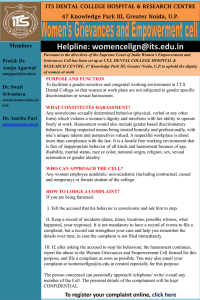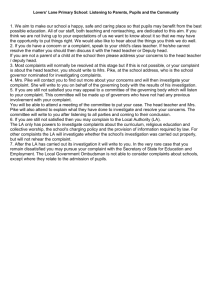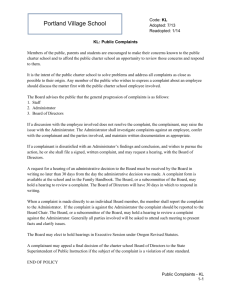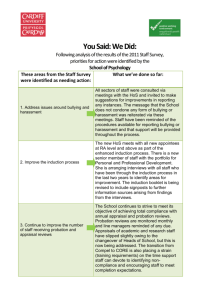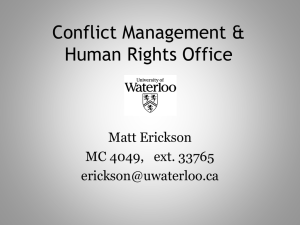Harassment & Bullying
advertisement
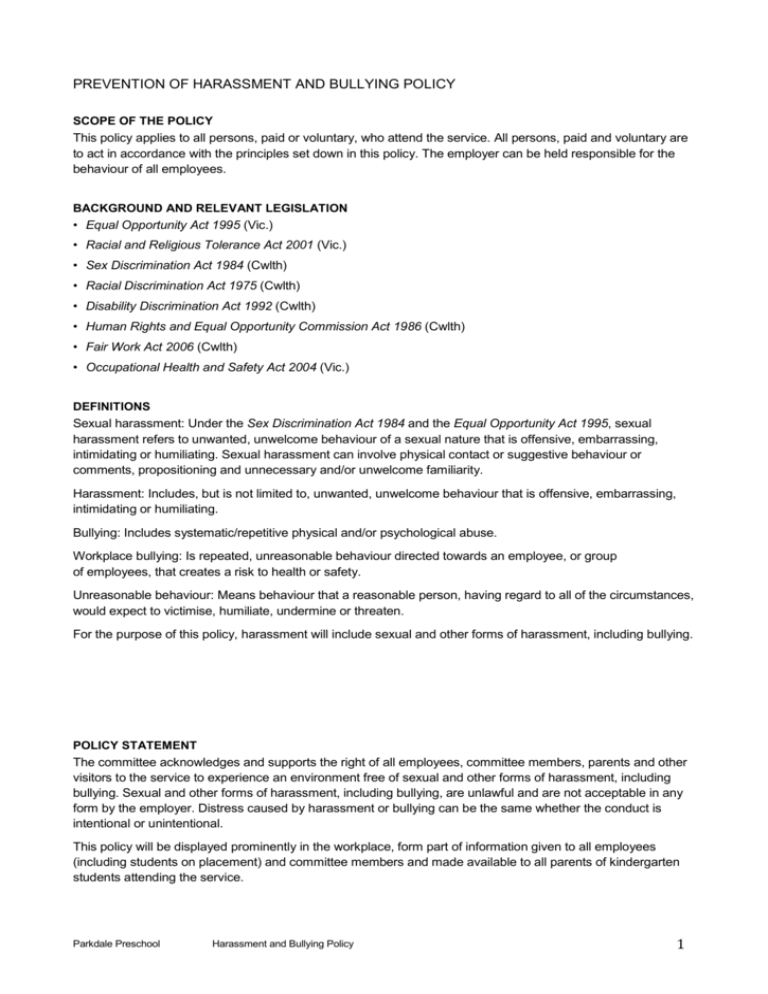
PREVENTION OF HARASSMENT AND BULLYING POLICY SCOPE OF THE POLICY This policy applies to all persons, paid or voluntary, who attend the service. All persons, paid and voluntary are to act in accordance with the principles set down in this policy. The employer can be held responsible for the behaviour of all employees. BACKGROUND AND RELEVANT LEGISLATION • Equal Opportunity Act 1995 (Vic.) • Racial and Religious Tolerance Act 2001 (Vic.) • Sex Discrimination Act 1984 (Cwlth) • Racial Discrimination Act 1975 (Cwlth) • Disability Discrimination Act 1992 (Cwlth) • Human Rights and Equal Opportunity Commission Act 1986 (Cwlth) • Fair Work Act 2006 (Cwlth) • Occupational Health and Safety Act 2004 (Vic.) DEFINITIONS Sexual harassment: Under the Sex Discrimination Act 1984 and the Equal Opportunity Act 1995, sexual harassment refers to unwanted, unwelcome behaviour of a sexual nature that is offensive, embarrassing, intimidating or humiliating. Sexual harassment can involve physical contact or suggestive behaviour or comments, propositioning and unnecessary and/or unwelcome familiarity. Harassment: Includes, but is not limited to, unwanted, unwelcome behaviour that is offensive, embarrassing, intimidating or humiliating. Bullying: Includes systematic/repetitive physical and/or psychological abuse. Workplace bullying: Is repeated, unreasonable behaviour directed towards an employee, or group of employees, that creates a risk to health or safety. Unreasonable behaviour: Means behaviour that a reasonable person, having regard to all of the circumstances, would expect to victimise, humiliate, undermine or threaten. For the purpose of this policy, harassment will include sexual and other forms of harassment, including bullying. POLICY STATEMENT The committee acknowledges and supports the right of all employees, committee members, parents and other visitors to the service to experience an environment free of sexual and other forms of harassment, including bullying. Sexual and other forms of harassment, including bullying, are unlawful and are not acceptable in any form by the employer. Distress caused by harassment or bullying can be the same whether the conduct is intentional or unintentional. This policy will be displayed prominently in the workplace, form part of information given to all employees (including students on placement) and committee members and made available to all parents of kindergarten students attending the service. Parkdale Preschool Harassment and Bullying Policy 1 HARASSMENT COMPLAINTS PROCEDURE Confidentiality is a cornerstone of this procedure. Any employee, committee member, parent or student on placement who uses the harassment reporting procedure will have the matter treated in the strictest confidence. Particular attention will be paid to the sensitive nature of a sexual harassment complaint and confidentiality will be maintained. To avoid any perceived conflict of interest, if the president, vice-president or other committee members are personally involved in issues as a complainant, or in allegations of discrimination, they will stand aside from participation in subcommittees or procedures related to the investigation or management of complaints. The service will ensure that all complaints/grievances in relation to harassment, regardless of whether they are of a major or minor nature, will be treated seriously and an investigation carried out fairly, efficiently and expeditiously. All parties to a grievance have the right to: • have grievances conducted in a fair, objective and unbiased manner • be treated with respect • be kept informed about the progress of the grievance • only have relevant factors taken into account in addressing the matter • not be subjected to any form of retribution, either stated or implied • have a support person present at all stages of the process, but not a legal representative. A support person may be a work colleague or union representative who may offer support but not act as an advocate • be informed, orally and in writing, of the outcome of the grievance, including reasons. All parties to the grievance are expected to: • respect and consider alternative views and opinions • fully participate in the grievance process. HARASSMENT REPORTING PROCEDURE Step 1: Opportunity for resolution If an employee is offended or believes he/she is the subject of harassment, the best response is to take firm and positive action. The aggrieved person is encouraged to make the person or persons aware that their actions are unwelcome/offensive/intimidating. If the behaviour continues or, if the aggrieved person feels he/she is unable to confront the person directly, the employer (once advised) should go to the president or, in their absence, the vice-president to: • advise that the nature of the behaviour may constitute harassment • explore possible strategies for resolving the difficulty without recourse to a formal complaint. Step 2: Lodgement of complaint If the problem is not, or cannot be, rectified by approaching the perpetrator of the alleged inappropriate behaviour, the following steps should be taken: • The aggrieved person should place a complaint in writing to the employer, marked for the attention of the president or, in their absence, the vice-president. The complaint should set out the nature and details of the matter, as well as any suggestions they have to resolve the complaint. • Once the complaint has been made, care will be taken not to discriminate against or victimise the complainant or the alleged harasser. • The president/vice-president should advise committee members of the receipt of the complaint at the earliest opportunity but no later than the next committee meeting. Parkdale Preschool Harassment and Bullying Policy 2 Step 3: Consultation about complaint The committee should establish a staffing subcommittee (ideally three people, one of whom should be an executive of the committee) to be elected at the first meeting of the year of the committee. This subcommittee should be given the authority to deal with any formal complaint lodged and to consult with the complainant and respondent and investigate and resolve the complaint as appropriate. It may be necessary to make a recommendation to the committee in order to resolve the matter. If a staffing subcommittee is not in existence, authority is delegated to the president or, in his/her absence, the vice-president, to appoint a minimum of three committee members (one of whom should be an executive of the committee) to investigate the complaint. Attempts will be made in all cases to resolve the complaint to the mutual satisfaction of those involved. This should occur as soon as is reasonably practicable. If the complaint is resolved as a result of formal consultation, the subcommittee (to the extent confidentiality allows) will report to the committee on the outcome of the process. Attempts will be made to resolve the complaint in consultation with and to the mutual satisfaction of those involved. Depending on the nature and severity of the matter the following action may be undertaken. The subcommittee will meet with the alleged harasser to formally notify him/her of the written complaint. This person must be advised of the following: • The right to have a support person present at all stages of the process, but not a legal representative. A support person may be a work colleague, union representative or friend who can offer support only as he/she is not there to act as an advocate. • Not to contact the complainant. • No action will be taken until he/she has had an opportunity to be heard. • If, after discussions with the alleged harasser, it appears that a simple modification of behaviour on the part of the alleged harasser will, to the satisfaction of the complainant, resolve the complaint, the subcommittee should agree with the complainant that no further action should be taken. If after a period of three months there are no further complaints, the matter will be closed. • The subcommittee will report back on their actions and findings (within the agreed confidentiality parameters) to the committee on completing their consultation processes. Step 4: Complaint investigation phase If it is not possible to resolve the complaint through discussions with relevant parties within an expeditious time, the subcommittee will conduct a formal investigation into the complaint. This investigation should be completed within five working days of the conclusion of the consultation phase. All documents related to the complaint will be kept confidential and shall not be produced or made available for inspection, except on instruction from a relevant authority consistent with the service’s privacy policy. The subcommittee will report (within the confidential terms of the investigation) back to the committee on completing the investigation. All documents related to the complaint will be kept confidential and shall not be produced or made available for inspection, except on instruction from a relevant authority in line with the service’s privacy policy. The committee will be kept informed of the progress of the investigation. During the period of investigation of serious sexual or other harassment, wherever possible the complainant and alleged harasser should not be required to work with each other in the same physical area, if requested by either party. Wherever possible, alternative working arrangements should be made if requested by either party. If this is not possible, the committee will arrange for a third person to be present whose role will be to monitor all contact. Within the constraints of confidentiality provisions of the investigation the subcommittee will report back to the committee on completing the investigation. Step 5: Resolution of complaint following investigation Parkdale Preschool Harassment and Bullying Policy 3 If, following investigation and resolution, a complaint is found to have foundation, the committee will determine an appropriate action plan that addresses the matters of concern and will take steps to immediately prevent a recurrence of the behaviour. Both parties will be told of the outcome of the investigation, recommendations (if any) and reasons. If the harasser is an employee, the complaint and resolution are to be noted on relevant personnel files. Where the incident involved an employee and disciplinary action taken was effective, or the action taken with a non-employee was effective, a check should be made at regular intervals to ensure that the behaviour has stopped and that the solution is working satisfactorily. Redress or compensation for the complainant may include a private or public written or verbal apology from the harasser. If, following investigation, the complaint is found to have no foundation, the complainant may be offered counselling. If it is considered that the complaint was made maliciously, action may be taken against the complainant. APPLICATION TO AN EXTERNAL ORGANISATION As sexual and disability harassment are breaches of Victorian and Commonwealth legislation, the aggrieved party is entitled to take their complaint at any time to a court of competent jurisdiction (for example The Equal Opportunity Commission (02) 9281 7111 or 1800 134 142) or The Human Rights and Equal Opportunity Commission, (02) 9284 9600 or 1300 656 419). KEY RESPONSIBILITIES The committee is responsible for: • implementing this policy • ensuring confidentiality is maintained • authorising change to this policy. The staffing subcommittee is responsible for: • responding to and investigating any complaints to the service that are covered by this policy • seeking assistance and advice from relevant organisations or persons in dealing with the complaint. Staff are responsible for: • complying with this policy. RESOURCES AND SUPPORT • Prevention of Bullying and Violence at Work, which is available from WorkSafe offices or their website on www.workcover.vic.gov.au • Victorian Equal Opportunity and Human Rights Commission: www.equalopportunitycommission.vic.gov.au EVALUATION To assess whether this policy has achieved the purposes set out in this policy the committee will: • monitor complaints received in relation to harassment • take into consideration feedback on this policy from employees, students on placement, volunteers, parents and committee members. AUTHORISATION This policy was approved on Wednesday 8th August 2012 by the Parkdale Preschool committee. Parkdale Preschool Harassment and Bullying Policy 4 REVIEW DATE - AUGUST 2014 This policy will be subject to regular review by the Committee in consultation with employees (and parents/guardians of students, as appropriate). Parkdale Preschool Harassment and Bullying Policy 5

